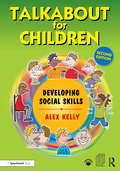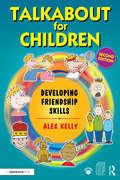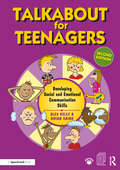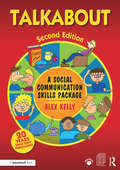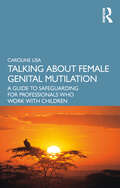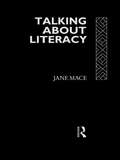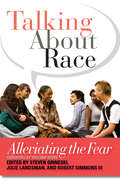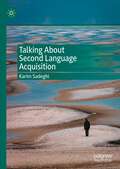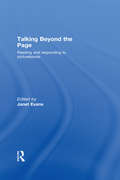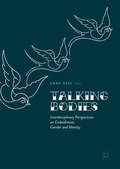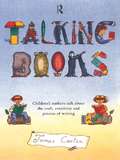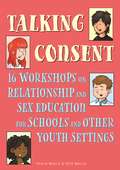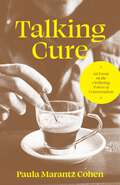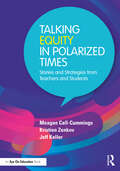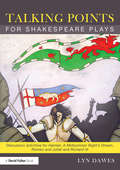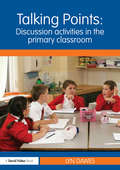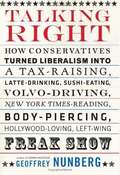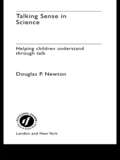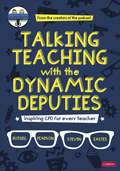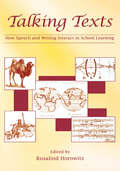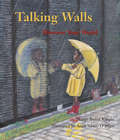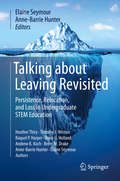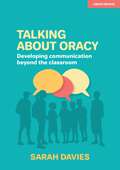- Table View
- List View
Talkabout for Children 2: Developing Social Skills (Talkabout)
by Alex KellyTalkabout for Children: Developing Social Skills is a bestselling professional workbook supporting educators and therapists who deliver social and relationship skills groups for children with social, emotional or behavioural difficulties. Social competence is an essential aspect of our quality of life and this resource will help to develop these skills in young children. This resources creates the second level of the Talkabout heirachy, where self-awareness comes before non-verbal skills and non-verbal comes before verbal, with assertiveness coming last. Resources include: an assessment framework planning and evaluation forms a three-term intervention plan for schools over 60 structured activity sessions focussing on social skills all the supplementary handouts and images needed to deliver the sessions. This second edition is presented with full-colour illustrations and handouts, and includes a new introduction by Alex Kelly reflecting on her own experiences of using the resources since they were first developed.
Talkabout for Children 3: Developing Friendship Skills (Talkabout)
by Alex KellyTalkabout for Children: Developing Friendship Skills is a bestselling professional workbook supporting educators and therapists who deliver social and relationship skills groups for children with social, emotional or behavioural difficulties. This resources creates the final level of the Talkabout heirachy, where self-awareness comes before non-verbal skills and non-verbal comes before verbal, with assertiveness coming last. Resources include: an assessment framework planning and evaluation forms a three-term intervention plan for schools over 25 structured activity sessions focussing on friendship skills all the supplementary handouts and images needed to deliver the sessions. This second edition is presented with full-colour illustrations and handouts, and includes a new introduction by Alex Kelly reflecting on her own experiences of using the resources since they were first developed.
Talkabout for Teenagers: Developing Social and Emotional Communication Skills (Talkabout)
by Alex Kelly Brian SainsTalkabout for Teenagers is a bestselling professional workbook supporting educators and therapists who deliver social and relationship skills groups for older children and young adults with social, emotional or behavioural difficulties. It is a complete group work resource that offers a hierarchical approach, with ready-made material to assist teaching social and relationship skills specifically to older children and young adults. Resources include: an assessment framework planning and evaluation forms 37 structured session guides focussing on self-awareness and self-esteem, body language, conversational skills, friendship skills and assertiveness all the supplementary handouts and images needed to deliver the sessions. This second edition is presented with full-colour illustrations and handouts, and includes a new introduction by Alex Kelly reflecting on her own experiences of using the resources since they were first developed.
Talkabout: A Social Communication Skills Package (Talkabout)
by Alex KellyThis core Talkabout manual is a practical resource essential for Speech and Language Therapists and other professionals who need to help people with special needs develop social skills. Over 60 activities form an extensive, structured social skills programme that can easily be adapted for use with children, adolescents and adults. Written by bestselling author and practising Speech and Language Therapist, Alex Kelly, this book sits at the centre of an internationally renowned series of resources supporting social skills. Contents include: a social skills assessment and intervention planning tool to help you identify the best way forward for each client or group over 60 activities focussing on body language, conversation and assertiveness 25 group cohesion activities to help you facilitate well-run, productive group sessions a wealth of handouts supporting the activities that can be freely downloaded and printed. This updated second edition of Talkabout sits alongside Talkabout for Teenagers and Talkabout for Adults, as well as three titles published for children (Developing Self Awareness and Self Esteem, Developing Social Skills and, Developing Friendship and Skills).
Talking About Female Genital Mutilation: A Guide to Safeguarding for Professionals who Work with Children
by Caroline LisaThis workbook is designed to be used to facilitate discussion and disseminate awareness amongst all professionals (social workers, teachers and health care professionals) who are required by law to report instances of Female Genital Mutilation (FGM). Suitable for use in group settings, it requires no prior knowledge of the subject, but is written in such a way for anyone to be able to facilitate a session with colleagues, which takes between one to three hours depending on the facilitator and group’s needs. Divided into five chapters, it shows how to facilitate a training session using the material, including being aware of how people may be triggered by this difficult subject. Providing activities to facilitate discussion, it explains terminology and provides explanation of different types of FGM, risk factors and legal aspects including mandatory reporting in certain regions. Designed to be concise, it will give busy professionals a quick and effective tool to disseminate information to as many colleagues as possible to allow them to develop understanding of a legal requirement of their job which has real and life-saving benefits for children.
Talking About Literacy: Principles and Practice of Adult Literacy Education
by Jane MaceTalking about Literacy re-examines dominant notions of what litreracy is, and challenges the problem-solution reflex to the issue (the problem is illiteracy: the solution is more literacy). Literacy has enormous emotional and political associations, and the job of literacy educator often concerns changing attitudes and challenging prejudices - whether in the form of publicity strategies, counselling new students, or in curriculum design. In short, adult literacy education means not only teaching courses like 'fresh start', 'basic skills', 'study skills', 'communication skills', 'language support' and 'return to study', but also designing strategies to encourage people to see that these courses may meet their own interests - and educating them and others to rethink their own negative attitudes to 'illiteracy'. The book looks in detail in at five principles put forward by Jane Mace as central to the education of people who often can read, but wish they could read better; who, technically can write, but have a desire to do so with more expression and coherence. These principles focus on five themes: context, inquiy, authorship, equality and community. Since it is all too easy for literacy education involving adults who do not have formal qualifications to stop short of teaching techniques for 'correct' writing, these principles mean taking seriously a view that adult students are writers as well as readers - that they have an entitlement to be read, as well as to read others.
Talking About Race: Alleviating the Fear
by Robert Simmons Julie Landsman Steven GrineskiWhat is it that gives many of us White people a visceral fear about discussing race?Do you realize that being able to not think about or talk about it is a uniquely White experience?Do you warn your children about how people might react to them; find store staff following or watching you; get stopped by the police for no reason?The students of color in your classroom experience discrimination every day, in small and large ways. They don’t often see themselves represented in their textbooks, and encounter hostility in school, and outside. For them race is a constant reality, and an issue they need, and want, to discuss. Failure to do so can inhibit their academic performance.Failure to discuss race prevents White students from getting a real, critical and deep understanding of our society and their place in it. It is essential for the well-being of all students that they learn to have constructive conversations about the history of race in this country, the impact of racism on different ethnic communities, and how those communities and cultures contribute to society. The need to model for our students how to talk openly and comfortably about race is critical in America today, but it is still an issue that is difficult to tackle.To overcome the common fear of discussing race, of saying “something wrong”, this book brings together over thirty contributions by teachers and students of different ethnicities and races who offer their experiences, ideas, and advice. With passion and sensitivity they: cover such topics as the development of racial consciousness and identity in children; admit their failures and continuing struggles; write about creating safe spaces and the climate that promotes thoughtful discussion; model self-reflection; demonstrate the importance of giving voice to students; recount how they responded to racial incidents and used current affairs to discuss oppression; describe courses and strategies they have developed; explain the “n” word; present exercises; and pose questions. For any teacher grappling with addressing race in the classroom, and for pre-service teachers confronting their anxieties about race, this book offers a rich resource of insights, approaches and guidance that will allay fears, and provide the reflective practitioner with the confidence to initiate and respond to discussion of race, from the pre-school and elementary classroom through high school.
Talking About Second Language Acquisition
by Karim SadeghiThis book includes interviews with fourteen internationally-acclaimed leading figures in Second Language Acquisition (SLA), who speak on seminal issues in the field as well as their own contributions to SLA scholarship. As well as covering the contributors’ backgrounds and academic achievements, the interviews also delve into their areas of expertise, current theoretical and practical considerations, and contemporary questions, developments and challenges in SLA. The author probes their views on current topics including input and interaction, vocabulary acquisition, teaching pronunciation, writing development, syntactic processing, multilingualism, L1 attrition, complex dynamic systems, processing instruction, instructed second language acquisition, and technology in language teaching. An introduction by the author draws out the key themes and debates in the field today, and highlights areas for future research and further exploration, and a foreword is provided by Rod Ellis. This book will be of interest to students and scholars of Applied Linguistics, Teacher Education and Methodology, and Second and Foreign Language Education.
Talking Beyond the Page: Reading and Responding to Picturebooks
by Janet EvansTalking Beyond the Page shows how different kinds of picturebooks can be used with children of all ages and highlights the positive educational gains to be made from reading, sharing, talking and writing about picturebooks. With contributions from some of the world's leading experts, chapters in this book consider how:children think about and respond to visual images and other aspects of picturebooks children’s responses can be qualitatively improved by encouraging them to think and talk about picturebooks before, during and after reading themthe non-text features of picturebooks, when considered in their own right, can help readers to make more sense out of the bookdifferent kinds of picturebooks, such as wordless, postmodern, multimodal and graphic novels, are structuredchildren can respond creatively to picturebooks as art formspicturebooks can help children deal with complex issues in their livesTalking beyond the Page also includes an exclusive interview with Anthony Browne who shares thoughts about his work as an author illustrator.This inspiring and thought provoking book is essential reading for teachers, student teachers, literacy consultants, academics interested in picturebook research and those organising and teaching on teacher education courses in children’s literature and literacy.
Talking Bodies
by Emma ReesIn this collection, leading thinkers, writers, and activists offer their responses to the simple question "Do I have a body, or am I my body?" The essays engage with the array of meanings that our bodies have today, ranging from considerations of nineteenth-century discourses of bodily shame and otherness, through to arguing for a brand new corporeal vocabulary for the twenty-first century. Increasing numbers of people are choosing to modify their bodies, but as the essays in this volume show, this is far from being a new practice: over hundreds of years, it has evolved and accrued new meanings. This richly interdisciplinary volume maps a range of cultural anxieties about the body, resulting in a timely and compelling book that makes a vital contribution to today's key debates about embodiment.
Talking Books: Children's Authors Talk About the Craft, Creativity and Process of Writing
by James CarterTalking Books sets out to show how some of the leading children's authors of the day respond to these and other similar questions. The authors featured are Neil Ardley, Ian Beck, Helen Cresswell, Gillian Cross, Terry Deary, Berlie Doherty, Alan Durant, Brian Moses, Philip Pullman, Celia Rees, Norman Silver, Jacqueline Wilson, and Benjamin Zephaniah.They discuss with great enthusiasm:*their childhood reading habits*how they came to be published*how they write on a daily basis*how a particular book came together*a type of writing that they are especially known for.Through in-depth interviews, they each reveal their approach to their craft. Much is know and spoken of the product that is the children's book, but it is rare that writers are given the opportunity to talk at length about the process of writing for children. Talking Books redresses the balance by presenting a wide selection of authors (of fiction, non-fiction and poetry) reflecting upon the joys and challenges of the craft, creativity and process of writing for children.
Talking Consent: 16 Workshops on Relationship and Sex Education for Schools and Other Youth Settings
by Pete Wallis Thalia WallisThis book provides teachers and parents with the 'need-to-knows' to educate groups of young people about consent, pornography, sexting and many other related topics, as well as giving them the tools to ward themselves against abusive behaviour.Initiating a discussion with young people on topics around sex can seem daunting, but Talking Consent is full of lesson plans, workshops and creative ideas for introducing and promoting constructive discussions around these areas - while also dispelling common myths, and giving appropriate answers to difficult questions that may arise from these discussions. Inclusive of everybody, including the LGBT+ community and people with disabilities, this book will provide professionals with the information they need to spark and shape conversation around these complex issues in an assured way.
Talking Cure: An Essay on the Civilizing Power of Conversation
by Paula Marantz CohenAn invigorating exploration of the pleasures and social benefits of conversationTalking Cure is a timely and enticing excursion into the art of good conversation. Paula Marantz Cohen reveals how conversation connects us in ways that social media never can and explains why simply talking to each other freely and without guile may be the cure to what ails our troubled society.Drawing on her lifelong immersion in literature and culture and her decades of experience as a teacher and critic, Cohen argues that we learn to converse in our families and then carry that knowledge into a broader world where we encounter diverse opinions and sensibilities. She discusses the role of food in encouraging conversation, the challenges of writing dialogue in fiction, the pros and cons of Zoom, the relationship of conversation to vaudeville acts, and the educational value of a good college seminar where students learn to talk about ideas. Cohen looks at some of the famous groups of writers and artists in history whose conversation fed their creativity, and details some of the habits that can result in bad conversation.Blending the immediacy of a beautifully crafted memoir with the conviviality of an intimate gathering with friends, Talking Cure makes a persuasive case for the civilizing value of conversation and is essential reading for anyone interested in the chatter that fuels culture.
Talking Equity in Polarized Times: Stories and Strategies from Teachers and Students
by Kristien Zenkov Meagan Call-Cummings Jeff KellerHow can teachers help students navigate tough topics in an increasingly politicized world? Featuring perspectives from teachers and students across the country, this unique book provides hope, applicable knowledge, and practical skills for teachers to address a range of current issues—including race, LGBTQIA+ advocacy, diversity and equity, civic engagement, ability and disability, school safety, social-emotional learning, immigration, and environmental justice.Each chapter addresses one of those controversial issues and examines how teachers are grappling with it in their own classrooms. Each chapter is also informed by youths’ insights, drawn from the authors’ work with the Youth Research Council and the Through Students’ Eyes project. Features include suggested resources, reflection questions, and talking points to support teachers in framing discussions of the topic positively and accurately.With the voices and skills in this book, you’ll be able to work with these issues no matter your own teaching contexts.
Talking Points for Shakespeare Plays: Discussion activities for Hamlet, A Midsummer Night's Dream, Romeo and Juliet and Richard III
by Lyn DawesWhat do students think about Shakespeare? Classic, timeless and full of rich ideas; or difficult, impenetrable and completely uninteresting? We want young people to develop a real interest in Shakespeare, based on their understanding and engagement with the texts. A meaningful classroom discussion that enables every individual to contribute and covers a range of viewpoints, can help students’ understanding of Shakespeare’s plays, consolidate their learning, and increase their motivation. This highly practical book enables teachers to organise, stimulate and support group discussions that will help students to relate to the characters, and develop their own ideas about the language and meaning. Drawing on four of the most commonly taught Shakespeare plays, the book provides a broad range of exciting tried and tested resources, taking the reader through key parts of the text, along with suggestions for further activities involving writing, drama and electronic media. Features include: -Scene by scene Talking Points for each play-'Thinking Together' extension activities for group work-Guidance on developing your own Talking Points-Talking Points focusing on Shakespeare’s language use Offering an accessible, thought-provoking and above all enjoyable way for students to engage with Shakespeare’s plays, this book will be highly beneficial reading for English teachers and trainees.
Talking Points: Discussion Activities In The Primary Classroom
by Lyn DawesTalking Points: Discussion Activities in the Primary Classroom encourages and supports classroom discussion on a range of topics, enabling children to develop the important life-skill of effective group communication. Children who can explain their own ideas and take account of the points of view and reasons of others are in the process of becoming truly educated. This book offers a straightforward way of teaching children discussion skills within the framework of a creative curriculum. The book provides an introduction on how to help children learn the skills of group discussion, offering six essential Talk Lessons to use in the classroom, alongside suggestions on how teachers can plan their lessons with a talk focus, set learning outcomes and create their own Talking Points to suit topics they are teaching. The main body of the book contains the Talking Points resources which are an excellent, tried and tested way of stimulating and supporting extended talk about a topic. The Talking Points in this book offer model for teachers to create further Talking Points for their own classes. The Talking Points included here offer discussion in several curriculum areas including:- Science Literacy Philosophy and creativity for children History Mathematics Art and Music This invaluable book offers engaging, stimulating and thought provoking ideas for children to pit their wits against, promoting skills in discussion, analysis, reasoning and interaction. It is highly beneficial reading for teachers working in Key Stage 2, head teachers and those responsible for staff development, as well as students on teacher training courses and graduate training programmes.
Talking Right: How Conservatives Turned Liberalism into a Tax-Raising, Latte-Drinking, Sushi-Eating, Volvo-Driving, New York Times-Reading, Body-Piercing, Hollywood-Loving, Left-Wing Freak Show
by Geoffrey NunbergA captivating, indignant, witty story of the "Great Re-labeling" of US language and thought from a master linguist, broadcaster and popular intellectual.
Talking Sense in Science: Helping Children Understand Through Talk
by Douglas Newton Douglas P NewtonTalking Sense in Science is a highly practical guide to getting the most out of primary science lessons through talking with children. This clearly written and straightforward book helps teachers to support understanding by developing their own interaction in the classroom. Each idea is described, illustrated and followed by a short task to develop teaching skills. This book looks at ways of understanding in science, and scientific language as well as how talk can support practical activities. Douglas Newton also addresses the ideas of what to say, when to say it and how to say it, with a view to developing understanding through science conversation. Examples given in the book span the range of primary school science topics, and provide an ideal sourcebook for lesson ideas. Talking Sense in Science is an essential buy for primary teachers who want an accessible way to improve their practice and their pupils' understanding in science. It is also an ideal learning tool for student teachers.
Talking Teaching with the Dynamic Deputies: Inspiring CPD for every teacher (Corwin Ltd)
by Russell Pearson Steve EastesTeaching remains an incredibly demanding and often ‘downtrodden’ profession but being a teacher can be a fabulous and rewarding job. This book offers uplifting professional learning for all teachers. It shines a light on the brilliant aspects of the job and helps readers to learn from some of the inspiring educators in the UK today. Russell Pearson and Steve Eastes are Primary Deputy Heads who run a popular education podcast for teachers. Interviewing educators for the podcast has shaped their understanding of key issues in education. *An uplifitng and inspiring learning tool for every teacher *Explores and unpicks lessons learned from ten inspiring educators *Focuses on key themes pertinent for all educators, regardless of their role or level of experience *Written in a truly authentic ‘voice’: from the perspective of real educators living and breathing daily school life
Talking Teaching with the Dynamic Deputies: Inspiring CPD for every teacher (Corwin Ltd)
by Russell Pearson Steve EastesTeaching remains an incredibly demanding and often ‘downtrodden’ profession but being a teacher can be a fabulous and rewarding job. This book offers uplifting professional learning for all teachers. It shines a light on the brilliant aspects of the job and helps readers to learn from some of the inspiring educators in the UK today. Russell Pearson and Steve Eastes are Primary Deputy Heads who run a popular education podcast for teachers. Interviewing educators for the podcast has shaped their understanding of key issues in education. *An uplifitng and inspiring learning tool for every teacher *Explores and unpicks lessons learned from ten inspiring educators *Focuses on key themes pertinent for all educators, regardless of their role or level of experience *Written in a truly authentic ‘voice’: from the perspective of real educators living and breathing daily school life
Talking Texts: How Speech and Writing Interact in School Learning
by Rosalind HorowitzThis volume examines how oral and written language function in school learning , and how oral texts can be successfully inter-connected to the written texts that are used on a daily basis in schools. Rather than argue for the prominence of one over the other, the goal is to help the reader gain a rich understanding of how both might work together to create a new discourse that ultimately creates new knowledge. Talking Texts: Provides historical background for the study of talk and text Presents examples of children’s and adolescents’ natural conversations as analyzed by linguists Addresses talk as it interfaces with domains of knowledge taught in schools to show how talk is related to and may be influenced by the structure, language, and activities of a specific discipline. Bringing together seminal lines of research to create a cohesive picture of discourse issues germane to classrooms and other learning settings, this volume is an essential resource for researchers, graduate students, classroom teachers, and curriculum specialists across the fields of discourse studies, literacy and English education, composition studies, language development, sociolinguistics, and applied linguistics.
Talking Walls: Discover Your World
by Margy Burns Knight Anne Sibley O'BrienIf walls could talk, what would they say? Perhaps they would tell us who built them and why. Maybe they could even tell us about people's lives today. In this book walls really do talk, and oh, the stories they tell. Talking Walls: Discover Your World combines and updates two earlier books, Talking Walls (1992) and Talking Walls: The Stories Continue (1996), which have sold 170,000copies. This new edition includes revised text that makes it more accessible to English Language Learners and easier to read aloud.
Talking about Leaving Revisited: Persistence, Relocation, and Loss in Undergraduate STEM Education
by Heather Thiry Timothy J. Weston Raquel P. Harper Dana G. Holland Andrew K. Koch Brent M. DrakeTalking about Leaving Revisited discusses findings from a five-year study that explores the extent, nature, and contributory causes of field-switching both from and among “STEM” majors, and what enables persistence to graduation. The book reflects on what has and has not changed since publication of Talking about Leaving: Why Undergraduates Leave the Sciences (Elaine Seymour & Nancy M. Hewitt, Westview Press, 1997). With the editors’ guidance, the authors of each chapter collaborate to address key questions, drawing on findings from each related study source: national and institutional data, interviews with faculty and students, structured observations and student assessments of teaching methods in STEM gateway courses. Pitched to a wide audience, engaging in style, and richly illustrated in the interviewees’ own words, this book affords the most comprehensive explanatory account to date of persistence, relocation and loss in undergraduate sciences.Comprehensively addresses the causes of loss from undergraduate STEM majors—an issue of ongoing national concern.Presents critical research relevant for nationwide STEM education reform efforts.Explores the reasons why talented undergraduates abandon STEM majors.Dispels popular causal myths about why students choose to leave STEM majors.This volume is based upon work supported by the Alfred P. Sloan Foundation Award No. 2012-6-05 and the National Science Foundation Award No. DUE 1224637.
Talking about Oracy: Developing communication beyond the classroom
by Sarah DaviesWhether considering the art of debate; understanding dialogic teaching methods; the necessity of questioning; or the ability to assess and develop these skills, this book has been written by a classroom teacher, for classroom teachers, in the hope that oracy is dragged out of the shadows and recognised for its significance to improving students’ life skills and future aspirations. When we think about the transferable skills all students will take with them post-academia, oracy, literacy and numeracy should logistically stand proudly side by side. This triad of skillsets are the key components that are used to measure intellectual development in childhood, as well as being further instilled and nurtured in all students throughout their education. However, as children become students and as these students become critical thinkers, an element of this crucial triad appears to have been disowned in recent years. In 2020, oracy appeared to have even less relevance in academia, with the only supportive provision for both Language and Literature to deal with any missed learning being the eradication of any recorded proof of this skill. Yet another indication that oracy has, in some circumstances, been cast into the shadows and banished into the realm of the subject specific curricular. We need to be realistic and embrace the idea that this skill is a necessity to success for all learners post-academia. Training students in the ability to communicate effectively with different audiences in different contexts, needs to be brought back into the spotlight in the hopes that we can attempt to resolve any misconceptions regarding oracy’s place in the curriculum. Through the recognition of the theoretical understanding of communication that will provide the foundations for this book, the aim is that it acts as a supportive guide that will provide suggestions and strategies in order to hopefully empower and encourage educators in all subjects in education, thus restoring the use and appreciation for this necessary skill both inside and outside the classroom. For so long, focus has been on the stress and rigor of assessments, and the fulfilment of the curriculum to ensure that all students can navigate their GCSE examinations. This book will question whether this will have a detrimental effect on students who may have been exposed to fewer of the skills that they will require when leaving an educational setting and venturing into everyday life. So, let’s address the elephant in the room, and provide it a voice.
Talking about Oracy: Developing communication beyond the classroom
by Sarah DaviesWhether considering the art of debate; understanding dialogic teaching methods; the necessity of questioning; or the ability to assess and develop these skills, this book has been written by a classroom teacher, for classroom teachers, in the hope that oracy is dragged out of the shadows and recognised for its significance to improving students’ life skills and future aspirations. When we think about the transferable skills all students will take with them post-academia, oracy, literacy and numeracy should logistically stand proudly side by side. This triad of skillsets are the key components that are used to measure intellectual development in childhood, as well as being further instilled and nurtured in all students throughout their education. However, as children become students and as these students become critical thinkers, an element of this crucial triad appears to have been disowned in recent years. In 2020, oracy appeared to have even less relevance in academia, with the only supportive provision for both Language and Literature to deal with any missed learning being the eradication of any recorded proof of this skill. Yet another indication that oracy has, in some circumstances, been cast into the shadows and banished into the realm of the subject specific curricular. We need to be realistic and embrace the idea that this skill is a necessity to success for all learners post-academia. Training students in the ability to communicate effectively with different audiences in different contexts, needs to be brought back into the spotlight in the hopes that we can attempt to resolve any misconceptions regarding oracy’s place in the curriculum. Through the recognition of the theoretical understanding of communication that will provide the foundations for this book, the aim is that it acts as a supportive guide that will provide suggestions and strategies in order to hopefully empower and encourage educators in all subjects in education, thus restoring the use and appreciation for this necessary skill both inside and outside the classroom. For so long, focus has been on the stress and rigor of assessments, and the fulfilment of the curriculum to ensure that all students can navigate their GCSE examinations. This book will question whether this will have a detrimental effect on students who may have been exposed to fewer of the skills that they will require when leaving an educational setting and venturing into everyday life. So, let’s address the elephant in the room, and provide it a voice.
